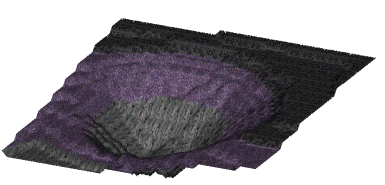Introducing Legends

A legend is a convenient way of assigning a consistent but unique appearance to a predefined value, or range of values. By creating and using legends, the representation of data may be made both distinctive and consistent between documents. The systematic use of legends makes the interpretation of data more intuitive.
Legends provides the tools for both editing existing legends and creating new legends. Filters, ranges, colors and display styles can all be set to facilitate the interpretation and presentation of drillhole and other data.
Using the Legend Manager utility, you can generate legends of various types, and interactively adjust bin sizes in relation to, for example, value frequency within the data records. This is a useful way to set up your legend bins so they are meaningful from the start, which could be particularly valuable when visualizing, say, grades in a model where a multimodal distribution is suspected.
Legends can be created either directly within the Legend Manager main screen, or using the Create New Legend wizard.
The Legend Manager gives you full control over your legend using interactive tools. For example, you can arrange your legend bin boundaries based on the apparent distribution of values indicated by the on-screen histogram. Supporting both linear and logarithmic representations, and granular control over the extent, range, colour, precision and number of bins, creating simple or complex legends is straightforward.

Frequently Asked Questions
If you are familiar with the basic premise of how legends work, you may find the following information useful:
Range Legends
Ranges are defined by an upper and a lower limit, and an appearance is assigned to the values that fall within the range. Ranges are typically used with geochemistry data to emphasize grade variability and to highlight significant results. If a value falls on the upper limit on one range and the lower limit of the next, it will be displayed with the settings of the first range. For example, if ranges of 0-1, 1-2 and 2-3 were defined, a value of 2 would use the display settings for the 1-2 range. See Range Legends.
Note: Ranges
are always specified with two values; these values represent
the minimum and maximum of the range. The first field represents
">=" (greater than or equal to) and the second
represents "<" (less than). For example, if "2"
is entered into the first field and "4" into the
second, the range will consist of all values greater than
and including 2, but less than (and excluding) 4.
Filter Legends
Filter are used to handle more complicated situations where simple values or ranges will not work. Filters are logical statements which define the conditions under which a specific legend appearance applies. Complex filters can be developed to map the variation of more than one variable. More about Filter Legends...
Lines, fills, symbols and colors
Legends provides everything you need to create legends to control line-styles, patterns, symbols and colors necessary to enhance the presentation of your data, and aid its interpretation.

Related topics and activities

